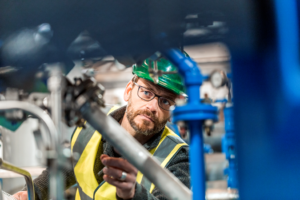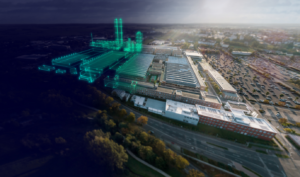
Manufacturers are searching for innovative ways to tackle a multitude of challenges, from rising product complexity and emerging sustainability goals to consumer demands for more customization. At the same time, they are dealing with global competition, supply chain and labor shortages.
Fortunately, manufacturers are discovering that digitalization is the new equalizer to achieve a new level of smart manufacturing. In the past, automation was focused on reducing costs. But today, if done right, digitalization can take manufacturing processes to a whole new level. Digitalization delivers more data and better data—key for improving operational efficiencies to achieve a host of benefits: high availability, maximized factory utilization, real-time management of supply chains, and most importantly, improved time to market. It also can enhance manufacturing flexibility – enabling individualized products at mass-produced goods pricing.
There are three key capabilities digitalization supports that will lead to smart manufacturing.
The first step is the convergence of information technology (IT) with operational technology (OT). This is crucial for extracting and analyzing all the data generated during operations to uncover actionable insights.
That, in turn, enables closed-loop manufacturing and execution focused on creating and optimizing the actual process and expediting customer orders.
Finally, closed-loop quality is achievable to ensure products are delivered right the first time, regardless of the lot size.
IT/OT fusion delivers actionable insights
The convergence of IT and OT is the initial crucial step to achieving smart manufacturing. Operation technology is the software that governs the operation of the physical equipment, the controls and the technology that’s driving the machines such as the PLCs. The software instructs the machine on what to do and ensures the hardware executes those instructions. On the other hand, IT is the organization’s computer technology used to store, retrieve, process, analyze, and recommend action on digital data extracted from operations. As a result, IT is used by management to make decisions, and operation technology is used by the factories to drive actions.
So where does all this data come from? Most factories today are a mix of older and newer equipment. Newer smart machines are designed to share data with a network, whereas older machines are data islands. A network of sensors is added to the factory to connect those islands to ensure robust data across all manufacturing operations, bringing operational data together for IT to analyze. As a result, in almost every factory, today, data is collected by a wide variety of physical sensing technologies, including programmable logic controllers (PLCs), sensors and gauges, IoT devices, etc.
This IT/OT fusion leads to:
- Greater flexibility and visibility into operations, empowering manufacturers to make much better decisions in an integrated manner. Now real-time process monitoring of the shop floor is possible, enabling managers to quickly assess the business impact of manufacturing activity.
- It also supports and encourages collaboration across planning and scheduling as well as factory performance, leading to superior efficiency.
- Additionally, artificial intelligence and machine learning can be applied to these large data sets, uncovering non-conformance and non-regular data to quickly make decisions based on that information.
 Closed-loop Manufacturing for continuous operational improvement
Closed-loop Manufacturing for continuous operational improvement
Closed-loop manufacturing and execution are now achievable based on the data and insights delivered by IT/OT fusion. Closed-loop manufacturing synchronizes and optimizes production across product design, production planning, manufacturing execution, automation and even intelligence from consumer use in the field. The result is a collaborative, connected loop of information that continuously improves the cost, time and quality of the manufacturing process to accelerate the delivery of products. In short, it tightens the alignment of the as-planned product with the as-built and as-used product in a continuous, iterative process.
Closed-loop manufacturing ensures that all teams have real-time information at each step in the manufacturing process—from product planning and engineering, through enterprise resource planning (ERP), across the supply chain and into actual manufacturing operations management (MOM). The rise of MOM on the factory floor enables manufacturers to collect and maintain a wealth of data on the production and the physical products being produced. It is now possible to encompass quality management, advanced planning and scheduling, manufacturing execution systems, enterprise manufacturing intelligence and more. Engineering teams can receive timely manufacturing feedback to expedite problem resolution and ensure optimal product evolution. It allows tracking of what has been built with all the data, how it was built, and with what materials and parts. It also fuels innovation by accelerating new product introduction for faster time to market, while maintaining fidelity to quality and compliance requirements.
There is a myriad of benefits to be reaped from real-time data from IT/OT fusion being shared in an iterative process in closed loop manufacturing. For instance, it is invaluable when identifying issues in assembly production that might require a change in a work instruction during volume production to optimize process planning. Or when a machine goes down, a manufacturer can quickly assess the impact on mid- to long-term planning, immediately identify alternate resource capacity, order prioritization, sequencing and synchronization, and quickly make the appropriate production changes.
Besides helping to adapt to immediate challenges, closed-loop manufacturing supports a host of higher-level smart manufacturing capabilities that can be efficiently and cost-effectively implemented. These include enterprise and multi-plant visibility, the development of key performance calculations, root cause analysis and advanced analytics.
99 percent quality compliance with closed-loop quality
Once closed-loop manufacturing is established, the third stage in achieving smart manufacturing is closed-loop product quality. Quality is a well-defined term in manufacturing: it is when the product outcome meets the intended expectations for product performance and features. The goal is to deliver on the intended quality for each and every product manufactured. Closed-loop manufacturing provides crucial real-time quality data that enables manufacturers to continually adjust the processes to optimize quality in real time. Or if real-time process adjustments are not feasible, closed-loop quality identifies parameter trends and their sources to allow adjustment at the first available downtime. When quality is subpar, the manufacturer can quickly identify and correct non-conformance as soon as practical, leading to overall improved quality of the product, while minimizing scrap and rework.
Specifically, closed-loop quality ensures complete visibility of quality-related metrics from planning through delivering on the quality of the completed product. It also focuses on improving the overall product quality over time. The first crucial step is planning for the quality upfront. That requires developing well-defined expectations and capabilities, defining expected failure modes, developing procedures for addressing those issues, and even looking at environmental and machinery conditions that may impact quality and the overall production processes. Those requirements often include vibrations, temperature, tolerances, machine condition and wear and the required precision or quality to ensure the product meets requirements.
Once all these quality conditions are clearly defined, it is crucial to monitor them throughout the manufacturing process. That involves capturing output parameters or as-built conditions against the requirements and closing the loop on the process to identify and zero in on the source of any parameter trends or deviations. Here is where the IT/OT data collection and closed-loop feedback in the manufacturing processes are essential. Now it is possible to optimize critical quality characteristics during the assembly of the product—whether a part or a complex system—and to continuously verify the product against the engineering requirements throughout the development and manufacturing process. It is even possible to extend this to include supplier quality management – especially in today’s highly challenged and often broken supply chain environment.
Organizations that establish closed-loop quality processes achieve a median product compliance rate of 99 percent, with a majority performance ranging from 97-100 percent. Manufacturers without this capability have significantly more variability in performance, with a majority ranging from 90 to 98 percent. This disparity in performance could mean the difference between being first or second to market, avoiding a major product recall or winning future contracts. One of the key advantages of implementing a closed-loop quality system is that it shifts quality to being a shared responsibility instead of treating it as a disconnected or isolated process.
Realizing a truly comprehensive digital twin
 Smart manufacturing, once implemented, supports the whole concept of a digital twin of the manufacturing environment. This is a critical game-changer for manufacturers positioning themselves for the future. The digital twin is a virtual, digital replica of the physical objects of an entire machine or the entire manufacturing system or the entire shop floor in a digital environment. While the factory operates, the digital twin provides a physically accurate simulation that combines the virtual and physical worlds to provide new insights and efficiencies for product manufacturing through data analytics and AI.
Smart manufacturing, once implemented, supports the whole concept of a digital twin of the manufacturing environment. This is a critical game-changer for manufacturers positioning themselves for the future. The digital twin is a virtual, digital replica of the physical objects of an entire machine or the entire manufacturing system or the entire shop floor in a digital environment. While the factory operates, the digital twin provides a physically accurate simulation that combines the virtual and physical worlds to provide new insights and efficiencies for product manufacturing through data analytics and AI.
More data equates to a higher fidelity digital twin. The IT and OT convergence delivers the requisite real-time data and information to create a comprehensive digital version of the factory. As a result, while the factory is running, the digital twin of the entire factory with each individual machine is mirroring that activity in a replica, digital format. All that operational data ensures much higher fidelity of the digital twin and provides insight into real-world operations.
The comprehensive digital twin is the basis for finally improving the real-world version via simulation of the digital model, thus closing the loop for manufacturing operations and quality. In addition, it provides manufacturers with a mechanism to understand what will or could happen in the future. As a result, they can confidently use the digital twin for optimizing operations, predicting maintenance, enabling more efficient commissioning, better changeovers and faster production line changes. All key capabilities for business operations to conduct their business in a more efficient manner. And a change in a digital environment does not cost anything; it’s a zero cost. That encourages managers to examine a broader range of feasible approaches before committing to physical implementation on the production floor.
Tomorrow’s smart manufacturing today
All the capabilities for creating tomorrow’s smart manufacturing are available today for those determined take their operations to the next level. The fusion of IT with OT data delivers a wealth of data that can be used to continuously improve operational efficiencies within a closed-loop manufacturing environment. That, in turn, enables a closed-loop quality approach to continuously enhance product quality. With a more agile and adaptable smart manufacturing process, it is feasible to optimize throughput while lowering costs and improving overall sustainability by minimizing resource usage, electricity, and water waste. Ultimately leading to the coveted Triple Zero in manufacturing: zero downtime, zero defect, and zero harm.
About the author
 Rahul Garg, Vice President of Industrial Machinery, Siemens Digital Industries Software, responsible for defining and delivering key strategic initiatives and solutions, and global business development. He and his team are responsible for identifying key initiatives and developing solutions for the industry while working closely with industry-leading customers and providing thought leadership on new and emerging issues faced by the machinery industry. Rahul’s experience and insight are derived from a 25-year career delivering software-based solutions for product engineering and manufacturing innovation for the global manufacturing industry, spanning a career in R&D to program management, sales and P&L management and having focused exclusively on the industrial machinery and heavy equipment industry since 2007.
Rahul Garg, Vice President of Industrial Machinery, Siemens Digital Industries Software, responsible for defining and delivering key strategic initiatives and solutions, and global business development. He and his team are responsible for identifying key initiatives and developing solutions for the industry while working closely with industry-leading customers and providing thought leadership on new and emerging issues faced by the machinery industry. Rahul’s experience and insight are derived from a 25-year career delivering software-based solutions for product engineering and manufacturing innovation for the global manufacturing industry, spanning a career in R&D to program management, sales and P&L management and having focused exclusively on the industrial machinery and heavy equipment industry since 2007.










































